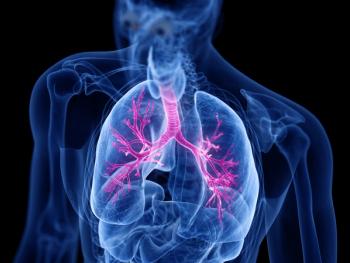
Novel Therapy Achieves Durable Complete Response Rate Treating High-Risk Bladder Cancer in Phase II Trial
Johnson & Johnson’s novel targeted therapy TAR-200 produced a greater than 80% complete response rate in patients with Bacillus Calmette-Guérin–unresponsive, high-risk non–muscle-invasive bladder cancer with carcinoma in situ.
Data from a Phase II trial for Johnson & Johnson’s novel targeted therapy TAR-200 showed the therapy produced a significant response rate in patients with Bacillus Calmette-Guérin (BCG)–unresponsive, high-risk non–muscle-invasive bladder cancer (NMIBC) with carcinoma in situ (CIS), who are ineligible for, or decided against, radical cystectomy.1 Findings from cohort two of the Phase IIb SunRISe-1 (
“The high complete response rate and durability of these responses observed in patients treated with TAR-200 underscores the potential of this treatment approach for patients with BCG-unresponsive HR-NMIBC,” presenting study author Joseph Jacob, MD, MS, Department of Urology, Upstate Medical University, said in a press release. “These results address an area of high unmet need for bladder sparing therapies in this patient population.”1
Current treatment recommendations for patients with NMIBC include radical cystectomy among those unresponsive to BCG therapy, which has a cancer-specific survival rate of 90% if performed prior to muscle-invasive progression. The disease typically impacts older patients, many of whom may be unwilling or unable to undergo radical cystectomy. With high rates of recurrence and progression, NMIBC creates a significant risk of morbidity and distress for this patient population.2
The FDA granted Breakthrough Therapy Designation (BTD) to TAR-200 for this indication in December 2023. The drug has an investigational targeted releasing system that allows for a controlled release of gemcitabine into the bladder, which can sustain local drug exposure over a period of weeks at a time, according to Johnson & Johnson. The drug’s safety and efficacy have been analyzed in patients with muscle-invasive bladder cancer across the
The BTD designation was based on findings from the randomized, parallel-assignment, open-label Phase 2b SunRISe-1 trial. The study analyzed the safety and efficacy of TAR-200 combined with cetrelimab, TAR-200 monotherapy, or cetrelimab monotherapy in patients with BCG-unresponsive HR-NMIBC CIS who are ineligible for, or elected not to undergo, radical cystectomy.
Participants were randomly assigned to one of four cohorts. Patients in cohort one were administered TAR-200 with cetrelimab, cohort two received TAR-200 monotherapy, cohort three received cetrelimab monotherapy, and cohort four received TAR-200 monotherapy for papillary disease only. The trial’s primary endpoint is CR rate at any time point, with secondary endpoints that include duration of response (DOR), overall survival, pharmacokinetics, quality of life, safety, and tolerability.2
The estimated one-year DOR rate in the TAR-200 monotherapy cohort was 74.6% (95% CI, 49.8-88.4), with median follow-up in responders of 29.9 weeks (range, 14-140). Among responders to the drug, 41 of 48 (85%) remained in CR at the data cutoff date of January 2, 2024. None of the patients who responded progressed to muscle-invasive bladder cancer or metastasis. Further, 47 of 48 responders achieved CRs at the first disease assessment at week 12 and four of five who completed two years of treatment remained in CR.
In terms of safety, treatment-related adverse events (TRAEs) were reported in 61 patients (71.8%), the most common of which (≥10%) being pollakiuria (35.3%), dysuria (29.4%), micturition urgency (15.3%), and urinary tract infections (15.3%). Seven patients (8.2%) reported grade three or higher TRAEs, four patients (4.7%) had one or more serious TRAE, and four patients (4.7%) had TRAEs that caused discontinuation; however, there were no deaths reported.
“These study results mark a significant step in our mission to bring new treatment options to patients that focus on bladder preservation and long-term survival,” Christopher Cutie, MD, vice president, Disease Area Leader, Bladder Cancer, Johnson & Johnson Innovative Medicine, said in a press release. “These results reinforce the potential of TAR-200 to transform the treatment landscape and our ongoing dedication to address unmet needs for patients facing this challenging disease.”1
References
1. TAR-200 monotherapy shows greater than 80% complete response rate in patients with high-risk non–muscle-invasive bladder cancer. News release. Johnson & Johnson. May 3, 2024. Accessed May 6, 2024.
2. Grab-Heyne K, et al. Intermediate and high-risk non-muscle-invasive bladder cancer: an overview of epidemiology, burden, and unmet needs. Front Oncol. 2023;13:1170124.
3. Johnson & Johnson’s Investigational TAR-200 Granted U.S. FDA Breakthrough Therapy Designation for the Treatment of High-Risk Non-Muscle-Invasive Bladder Cancer. Johnson & Johnson. News release. December 5, 2023. Accessed May 6, 2024.
Newsletter
Stay current in clinical research with Applied Clinical Trials, providing expert insights, regulatory updates, and practical strategies for successful clinical trial design and execution.



